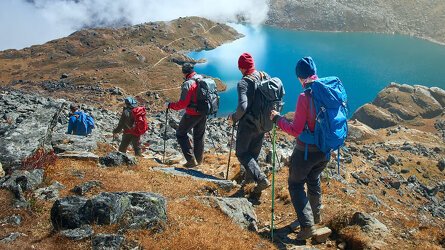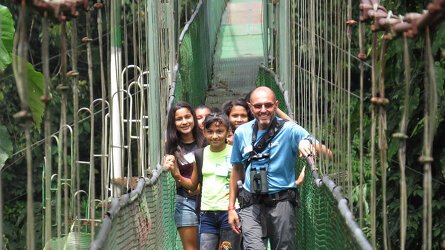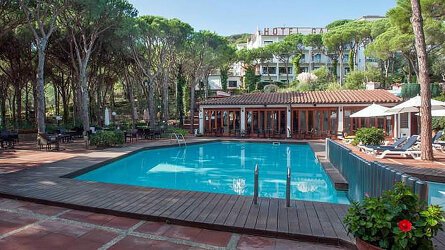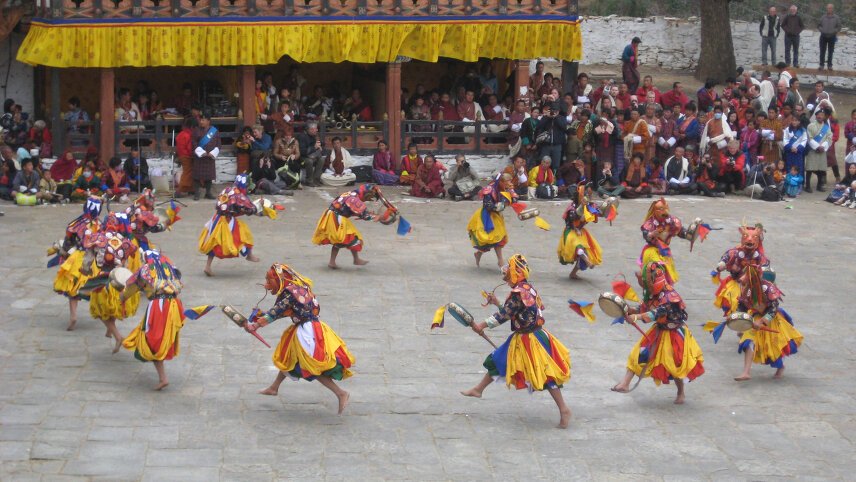Overview
Please note:...read more This itinerary is valid for departures starting in Kathmandu on 20 September 2026 attending Thimphu Festival. See the Paro Festival itinerary for departures starting in Kathmandu on 23 March 2026. See the Trongsa Festival itinerary for departures starting in Kathmandu on 14 December 2026.
Itinerary
Welcome to Kathmandu, a brief stop en route to Bhutan.
On arrival, you are met by a local representative for your transfer to our hotel. Please check the Joining Instructions for information on how to confirm your transfer. The evening is free to relax. Stay: Royal Singi Hotel (or similar).
Today we fly to Paro. Our route takes us over the eastern Himalaya and, if the weather is clear, we should get a fantastic view of magnificent peaks including Everest, Lhotse, Nuptse, Makalu and Kanchenjunga. The Paro Valley is considered one of the most beautiful in Bhutan, with blue pine-covered hills and attractive solidly built houses among the paddy fields. If there is time in the afternoon, we can visit the museum and Rinpung Dzong. Stay: Rema Resorts (or similar) (B/L/D).
We have an early start today, driving one hour from Paro to Thimphu to find our spot to enjoy the festival entertainment from. Thimphu is considered the most popular festival in Bhutan and plays an important part in the Bhutanese lives. We spend the whole day experiencing this vibrant festival, watching the Bhutanese gather to see monks and lay dancers dressed in colourful brocade and silk costumes, wearing painted masks re-enacting the stories of the religious and lay history of Bhutan through music and dance.
For several days, there are masked dances and prayer meetings, and a general carnival atmosphere prevails as villagers arrive to meet old friends. The Bhutanese all dress in their finest national dress for the festival and one of the highlights is the riot of colours of the magnificent silks on display. Stay: Gakyil Hotel (or similar) (B/L/D).
We take a break from the festivities and enjoy the sights and history of the Thimphu, the relatively new capital of the Kingdom of Bhutan. The ancient city of Punakha was replaced by Thimphu as the capital in 1961 by the third king, Druk Gyalpo Jigme Dorji Wangchuck. The main sights include Kuensel Phodrang, known locally as Buddha Point, where there is a huge statue of Buddha overlooking the whole valley. Simtokha Dzong, the oldest dzong in Bhutan, built in 1629, now serves as the Institute of Language and Cultural Studies.
It houses numerous statues and paintings of various religious figures and deities. You can also view Takin Reserve from above on your journey into Thimphu and visit a paper factory and weaving centre to see authentic local weaving techniques, plus the local market is interesting to explore. Stay: Gakyil Hotel (or similar) (B/L/D).
We leave Thimphu in the morning and drive east to Gangtey. The route climbs steadily on a good road to the Dochula Pass, where there are 108 chortens (Buddhist shrines). At 10,000ft (3,050m), we can enjoy glorious views over the eastern Himalaya, weather dependent. We then descend to the valley floor and continue to sub-tropical Wangdue. We stop to visit the Wangdiphodrang Dzong, one of the larger monastery's we visit on this trip it overlooks the picturesque river and rural agricultural fields surrounding it and has an impressive courtyard.
This afternoon, we have plenty of time to explore the Phobjikha Valley, one of the most beautiful in Bhutan. This wide-open U-shaped glacial valley is home to barking and sambar deer plus wild boars, while Himalayan black bears have also been spotted here. It is also where black-necked cranes come roost during winter.
Usually arriving from Tibet towards the end of October, they announce their appearance by circling the monastery three times. Come spring, they again fly three times around the monastery before returning to Tibet. Today's drive is approximately 78mi (125km) and takes four to five hours, although variable road conditions may mean we spend longer on the road. Stay: Phuntsho Yangkhil Lodge (or similar) (B/L/D).
This morning, we set off on foot from our hotel for a walk through the Gangtey Valley (approximately 3mi/5km, two to three hours) – the climb up to the monastery involves around 1,640ft (500m) ascent. This glacial valley comprises farmlands, pastures and blue-pine forests and we may encounter herders caring for their livestock.
After lunch, we visit the 15th-century Khewang Lhakhang, on the east side of the Phobjikha Valley. It features a trio of two-storey statues depicting the past, present and future Buddhas. We can also visit the Black-Necked Crane Visitor Center, where we learn about the conservation efforts to protect these majestic birds. We also have a short visit to a farmhouse and an optional hot-stone bath, which costs approximately 830 ngultrums (US$10). Stay: Phuntsho Yangkhil Lodge (or similar) (B/L/D).
We drive back westwards to subtropical Punakha, which may take about three hours. En route, we visit the Chimi Lhakhang, built in 1499 to honour Drukpa Kuenley. Nicknamed the Divine Madman or Mad Saint, he was a maverick spiritual leader, who subdued a demon controlling the Dochu La. He built a chorten where the monastery stands and was reputed to have unorthodox ways of teaching Buddhism – he advocated for phallic symbols to be painted on walls and houses, which were intended to drive away the evil eye.
Most of the houses in this area are decorated with highly ornate phallic paintings. We walk through the village to the monastery with a chance to see traditional Bhutanese-style farmhouses. We then continue to Punakha, which at 3,940ft (1,200m) is warmer than Paro or Thimphu. Punakha was once the capital of Bhutan and is still the winter residence of the monastic body. We visit the dzong, one of the most beautiful in Bhutan. This remarkable fortress between the Mo and Po Chhu rivers has survived many fires, an earthquake and several floods.
Time permitting, we drive to the Khamsum Yuelley Namgyal Chorten at the end of the valley, which houses representations of the tantric form of Buddhist deities. Built for the protection of the country and the present king, the chorten also offers impressive views of the valley below. Stay: Sonamgang Hotel (or similar) (B/L/D).
In the morning, we drive for about three hours back to Paro. En route, we visit the Tachogang Lhakhang Bridge, which crosses the Paro Chhu. This 600-year-old bridge, which is popularly known as the Iron Chain Bridge, was built by Thangtong Gyalpo in the late 1300s, who is said to have built 108 bridges in Tibet and Bhutan. Made of wood and iron, this is the first bridge to have ever been built in Bhutan. We continue our drive and come to the Dzongdrakha Goemba, also known as Mini Taktsang, a serene site above the village of Bondey on the western side of the Paro Valley.
Often overlooked by tourists because of its rather old facade, this divine place comprises four shrines, while stories related to spirits, saints and magic are narrated here. Before arriving at our hotel, we stop at Kyichu Lhakhang. Built in the seventh century, it is said to be the oldest temple in Bhutan and therefore holds great spiritual significance to the country. Legend says a king built it in one night on an ogre's foot. Stay: Rema Resorts (or similar) (B/L/D).
Today we hike (approximately 6. 8mi/11km round trip with an elevation of approximately 915m) to Taktsang Monastery, also known as the Tiger's Nest. This spectacular building is perched on the ledge of a cliff high above the Paro Valley. Partly destroyed by fire in 1998, it has now been completely restored to its former magnificence. From the car park to the cafeteria viewpoint is about two hours' uphill walk through the forest. From here, we have incredible views of the monastic buildings that cling to the cliff. For the energetic, there is the chance to walk even higher to the actual monastery.
This takes another two hours and involves walking up and down stone steps. We highly recommend a trekking pole or you can buy a wooden stick at the car park. There are horses available up to the cafeteria for those who do not wish to hike but please note this is an unregulated activity and helmets are not available.
We spend about an hour at the monastery looking around the temples (photography is not allowed inside) before descending to the cafeteria for lunch. After lunch, we return to the car park and drive back to our hotel. There should be some time to have a look round Paro before dinner. Stay: Rema Resorts (or similar) (B/L/D).
We transfer to the airport to check in for our flight back to Kathmandu. The rest of the day is free for individual sightseeing or shopping. You may want to visit Durbar Square in the heart of the old city, the monkey temple at Swayambhunath, the largest Buddhist stupa on earth at Boudhanath or the Hindu temple at Pashupathinath.
Another option is to take a taxi to Bhaktapur, the medieval city 10. 5mi (17km) east of the capital. Bhaktapur has its own Durbar Square with many temples and statues and a maze of narrow streets, which are generally quieter than the capital. The Exodus representative in Kathmandu can give you more information on what there is to see. Stay: Royal Singi Hotel (or similar) (B).
Your journey ends Kathmandu after breakfast. If you don't want the adventure to end, speak to your sales representative about extending your stay (B).
Trip Inclusions
- Experience the colourful masked dance festivals of Bhutan
- Visit the Paro Dzong and the incredible Tiger's Nest monastery at Taktsang
- Drive across the Dochu La and visit Punakha Dzong
- Walk in the quiet Gangtey Valley
- Visit the impressive Simtokha Dzong, the oldest fortress in Thimphu
- 10 nights in hotels
- Full-day festival experience in Thimphu
- Travel by private minibus
- All breakfasts, eight lunches, eight dinners
- All transport and listed activities
- Tour leader throughout
- Free arrival and departure transfers for everyone
- Bhutanese visa
- Itinerary and inclusions are subject to change
- Price is for land, cruise and internal flights as specified. Flights not specified are not included

From classic small group tours & family adventures, to walking holidays, cycling trips and self-guided tours. Read more

Exodus chooses their Leaders carefully. Professional, dedicated and are passionate about sharing their home countries. Read more

Wherever possible, Exodus chooses properties that are locally owned and that reflect the area you are visiting. Read more
Availability
A definite departure means minimum numbers have been reached for this departure to operate. Your Global Journeys Travel Advisor will check the availability of your departure date when you enquire. Additional savings may apply. We guarantee the lowest price in Australia. T&C’s apply.
Tour & cruises prices are per person. Prices shown have savings applied, are subject to availability and may be withdrawn at any time without notice. Pricing and trip details are correct at this point in time, however are subject to confirmation at the time of booking and are subject to change by Exodus. For cruise itineraries, cabin images are sourced from Exodus. These should be treated as indicative only. Cabin inclusions, upholsteries and room layout may differ to the image(s) shown depending on the ship selected and your sailing dates.









